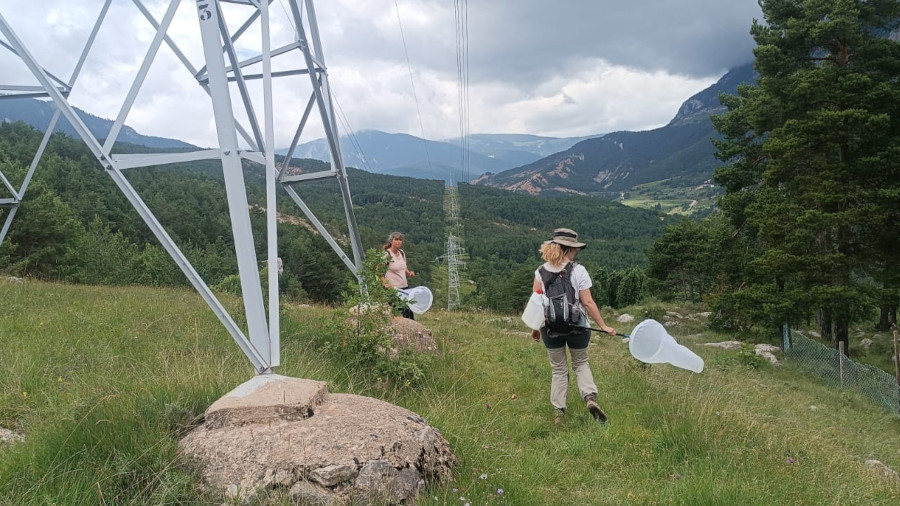The Alcon blue butterfly, an endangered species in Catalonia, detected under the electricity transmission lines
UAB researchers have been analysing the behaviour of biodiversity under the Electricity Network power lines since 2020. Butterflies and other insects form biodiversity oases in open sites under power lines.

Researchers from the Universitat Autònoma de Barcelona (UAB) have detected new locations of alcon blue butterfly (Phengaris alcon) colonies under the transmission lines of Red Eléctrica, which could serve as a refuge for biodiversity and, in particular, for species of open areas such as this lepidopteran, one of the most endangered species in Catalonia.
Like many other insects and pollinators, the alcon blue is in decline in Catalonia, where its distribution is limited to specific areas of the Pyrenees and other localities in open areas, often linked to extensive mountain livestock farming, and also in mowing meadows. Reasons for their population decline are, to a large extent, changes in land use and other human-induced modifications.
Specifically, the decrease in traditional livestock uses has led to the growth of scrubland and the expansion of the forest, the fragmentation of its habitat which, together with the small size of some of its populations, is causing the disappearance of the populations of this species.
This regressive trend has led to the fact that the alcon blue is currently classified as “threatened” in the catalogue of fauna of Catalonia and in the Atlas y libro rojo de los invertebrados de España [Atlas and Red Book of Invertebrates of Spain] of the Ministry for Ecological Transition and Demographic Challenge.
The discovery of these new sites and colonies was possible thanks to the "Naturaleza en Red" collaboration between Redeia, Red Eléctrica's parent company, the Universitat Autònoma de Barcelona, and the environmental organisation Bufalvent, which carry out a joint project with the aim of conducting research on the biodiversity existing under the power lines; evaluating the effect of management on the fauna and flora, and mapping the lines with a greater interest as biodiversity refuges for species in open areas.
Four years of study
Naturaleza en Red began in 2020 and is focused on pollinators, as well as on the flora associated with open spaces generated by forest management under the safety roads of power transmission lines and electricity pylons (also called "towers").
In this manner, not only was it possible to evaluate the richness and abundance of butterfly species, but also of insects from the Diptera (flies) and Hymenoptera (ants, wasps and bees) orders. In addition, the researchers of the project, Xavier Munill, Ana Morton and María Font, highlighted the large number of orchid species detected under these electricity lines.
“Power lines create a discontinuous mosaic of unique refuges for open space species. These islands of biodiversity, in many cases, are vital spaces, due to the current degree of threat to some species of flora and fauna. This study offers a new vision of areas with forest management under power lines, which allows the maintenance and management of pollinator species and unique flora,” explains Ana Morton, lecturer in the Department of Animal Biology, Plant Biology and Ecology at the UAB.
In the past two decades, pollinators have suffered a reduction in their populations at local, European and global levels. This group of insects is fundamental to the ecosystem because they not only keep it healthy and resilient, but are also key to agriculture and human health.
Power lines, biodiversity corridors
The results of this study financed by Redeia will make it possible to evaluate the richness and abundance of fauna and flora concentrated in these spaces under the power lines, the presence of threatened or endangered species, and the effect of the lines as biodiversity hotspots. It is hoped that these results will help in carrying out a management that takes into account the most vulnerable species, in order to favour their conservation and dispersal.
“This scientific collaboration allows us to demonstrate that power lines behave as biodiversity corridors, creating spaces and opportunities for wildlife and vegetation. They are 'oases' that provide shelter and food for a wide variety of fauna. Thus, under the power lines, many species move through the territory. In fact, the electricity transmission network in Spain could connect 60% of the Natura 2000 Network,” says Antonio Calvo Roy, Redeia's Sustainability Director.